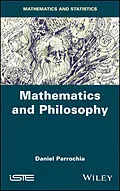This book, which studies the links between mathematics and philosophy, highlights a reversal. Initially, the (Greek) philosophers were also mathematicians (geometers). Their vision of the world stemmed from their research in this field (rational and irrational numbers, problem of duplicating the cube, trisection of the angle...). Subsequently, mathematicians freed themselves from philosophy (with Analysis, differential Calculus, Algebra, Topology, etc.), but their researches continued to inspire philosophers (Descartes, Leibniz, Hegel, Husserl, etc.). However, from a certain level of complexity, the mathematicians themselves became philosophers (a movement that begins with Wronsky and Clifford, and continues until Grothendieck).
Autorentext
Parrochia Daniel, Université Jean Moulin, Lyon.
Inhalt
Introduction xi
Part 1. The Contribution of MathematicianPhilosophers 1
Introduction to Part 1 3
Chapter 1. Irrational Quantities 7
1.1. The appearance of irrationals or the end of the Pythagorean dream 8
1.2. The first philosophical impact 9
1.3. Consequences of the discovery of irrationals 11
1.3.1. The end of the eternal return 11
1.3.2. Abandoning the golden ratio 11
1.3.3. The problem of di3.1sorder in medicine, morals and politics 12
1.4. Possible solutions 12
1.5. A famous example: the golden number 14
1.6. Plato and the dichotomic processes 16
1.7. The Platonic generalization of ancient Pythagoreanism 17
1.7.1. The Divided Line analogy 17
1.7.2. The algebraic interpretation 18
1.7.2.1. Impossibilities 19
1.7.2.2. The case where k = Ø 19
1.8. Epistemological consequences: the evolution of reason 20
Chapter 2. All About the Doubling of the Cube 23
2.1. History of the question of doubling a cube 24
2.2. The non-rationality of the solution 24
2.2.1. Demonstration 24
2.2.2. The diagonal is not a solution 25
2.3. The theory proposed by Hippocrates of Chios 25
2.4. A philosophical application: platonic cosmology 27
2.5. The problem and its solutions 29
2.5.1. The future of the problem 29
2.5.2. Some solutions proposed by authors of the classical age 30
2.5.2.1. Mechanical solutions 30
2.5.2.2. Analytical solution 31
2.5.3. The doubling of the cube going beyond Archytas: the evolution of mathematical methods 36
2.5.3.1. Menaechmus' solution 37
2.5.3.2. A brief overview of the other solutions 39
2.6. The trisection of an angle 40
2.6.1. Bold mathematicians 40
2.6.2. Plato, the tripartition of the soul and self-propulsion 42
2.6.3. A very essential shell 44
2.6.4. A final excercus 46
2.7. Impossible problems and badly formulated problems 46
2.8. The modern demonstration 47
Chapter 3. Quadratures, Trigonometry and Transcendance 51
3.1. the mysterious number 52
3.2. The error of the squarers 53
3.3. The explicit computation of 55
3.4. Trigonometric considerations 57
3.5. The paradoxical philosophy of Nicholas of Cusa 59
3.5.1. An attempt at computing an approximate value for 59
3.5.2. Philosophical extension 61
3.6. What came next and the conclusion to the history of 63
3.6.1. The age of infinite products 64
3.6.2. Machin's algorithm 64
3.6.3. The problem of the nature of 65
3.6.4. Numerical and philosophical transcendance: Kant, Lambert and Legendre 66
Part 2. Mathematics Becomes More Powerful 69
Introduction to Part 2 71
Chapter 4. Exploring Mathesis in the 17th Century 75
4.1. The innovations of Cartesian mathematics 76
4.2. The plan for Descartes' Geometry 79
4.3. Studying the classification of curves 79
4.3.1. Possible explanations for the mistakes made by the Ancients 81
4.3.2. Conditions for the admissibility of curves in geometry 83
4.4. Legitimate constructions 85
4.5. Scientific consequences of Cartesian definitions 87
4.6. Metaphysical consequences of Cartesian mathematics 88
Chapter 5. The Question of Infinitesimals 91
5.1. Antiquity the prehistory of the infinite 92
5.1.1. Infinity as Anaximander saw it 92
5.1.2. The problem of irrationals and Zeno's paradoxes 93
5.1.3. Aristotle and the dual nature of the Infinite 96
5.2. The birth of the infinitesimal calculus 98
5.2.1. Newton's Writings 99
5.2.2. Leibniz's contribution 101
5.2.3. The impact of calculus on Leibnizian philosophy 10...
